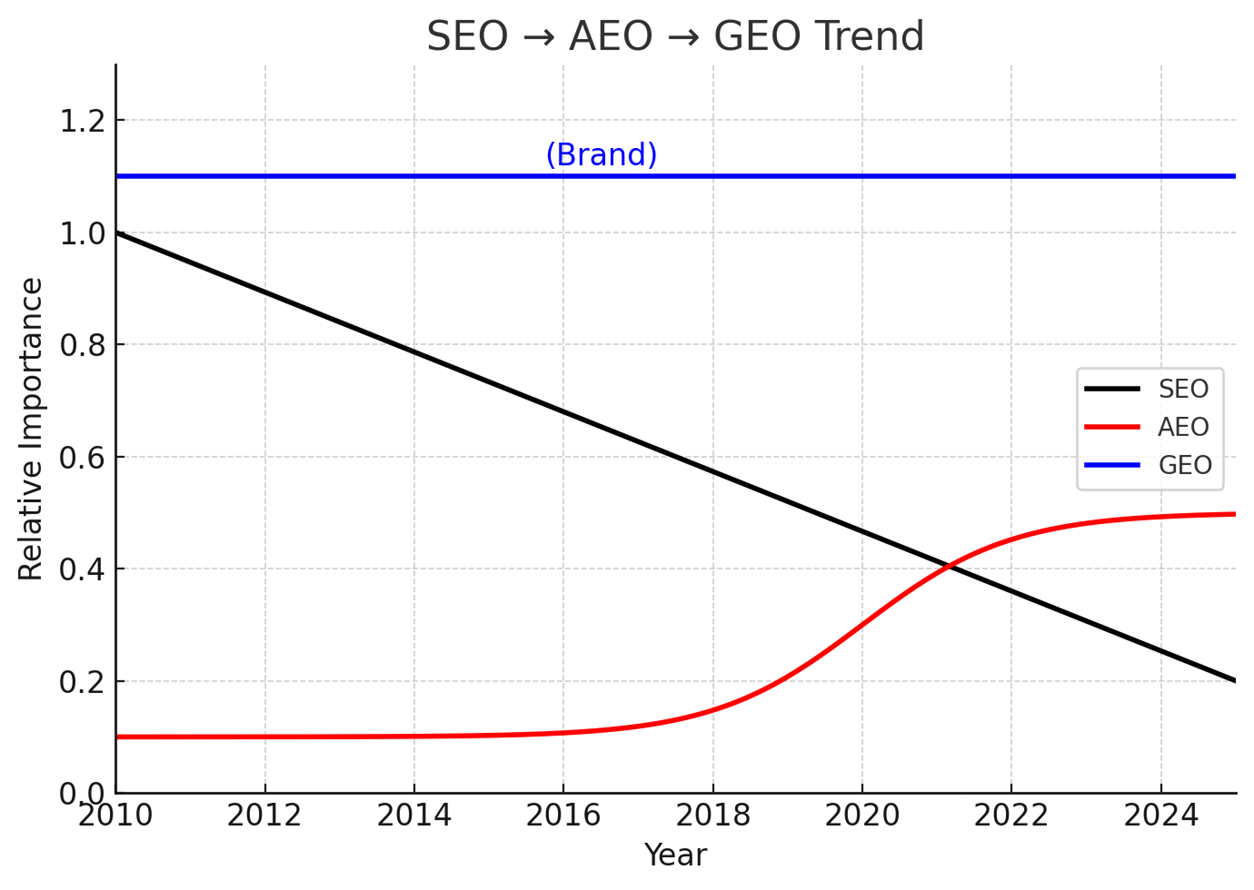Introduction: A New Frontier in Visibility*
For more than two decades, digital marketing has revolved around search engines. Brands competed for rankings on Google, invested in SEO playbooks, and built inbound marketing machines. But the terrain has shifted. Increasingly, customers don’t just “search” – they ask AI. Tools like ChatGPT, Perplexity, Bing Copilot, and Google’s AI Overviews are rewriting the journey from curiosity to consideration.
But this raises a critical question: if this is true, then what does AI say about your brand? What impact does it have on your marketing?
Unlike search engines, which display lists of links, generative engines produce answers. If your brand is absent from those answers, you are invisible – even if your site is technically well-optimized for search. Visibility in the AI era requires new strategies, grounded in both marketing practice and cognitive science.
That’s where Generative Engine Optimization (GEO) comes in: the discipline of ensuring your brand is embedded in the priors that AI systems draw on when producing content. Alongside GEO, Answer Engine Optimization (AEO) provides near-term tactics for appearing in AI-generated answers today.
This article draws on my background in mathematics, psychology, and early machine learning, together with two decades leading marketing in B2B SaaS, to explore the theory and practice of GEO and AEO – and why they matter for the next decade of marketing.
From Psychology to AI: How Decisions Are Made
Marketers often forget that human decision-making is not purely rational. People don’t start from a blank slate when choosing between brands – they begin with priors: mental shortcuts, schemas, and brand associations.
Psychologists call this process schema-based decision-making. Everyone arrives at a buying decision with a pre-existing set of beliefs. For example:
– Apple = premium design
– Samsung = high-spec Androids
– Xiaomi = budget-friendly
New evidence – reviews, product pages, recommendations – gets filtered through these priors (or at least “combined with”). The process is mathematically described by Bayesian updating: starting from a prior belief, and updating it with new evidence to form a posterior belief (the decision).
“Rational decision making under uncertainty requires forming beliefs that integrate prior and new information through Bayes’ rule.”
In consumer behavior, Bayesian models describe how customers revise brand expectations as they encounter new information.
AI Works the Same Way
Generative AI mirrors this process. Large language models (LLMs) have priors (training data, embeddings, parameters) and evidence (retrieved documents, prompts). When asked a question, the model integrates both to generate an answer – much like a human updating beliefs with new information.
That means marketers must now think in Bayesian terms not only about human buyers, but about AI engines as decision-makers.
SEO in Decline: A Saturated Market
For years, SEO was the growth engine of B2B marketing. Publish content, build backlinks, climb the rankings. But in 2025, SEO faces three challenges:
1. Market Saturation
– Most categories are dominated by entrenched incumbents with high domain authority.
– New entrants struggle to gain traction without massive resources.
2. Standardization
– Everyone uses the same tools (Ahrefs, SEMrush, Clearscope).
– Agencies follow the same playbooks.
– What once gave an edge is now a commodity.
3. AI Intermediation
– Google AI Overviews, ChatGPT, and Perplexity strip away organic clicks.
– Even well-optimized content is paraphrased by AI, with fewer users clicking through.
SEO is no longer an offensive play – it’s defensive. If you already rank, you defend that ground. But building a new presence from scratch is brutally hard.
GEO vs. AEO: Two Paths to AI Visibility
To navigate this new landscape, I distinguish two complementary disciplines:
Generative Engine Optimization (GEO)
– Analogy: Brand advertising.
– Nature: Long-term, cumulative, hard to measure.
– Goal: Shape the priors inside AI systems so your brand is included in their answers.
– How: Structured content, metadata, thought leadership, embedding strategies, visibility in trusted sources.
Answer Engine Optimization (AEO)
– Analogy: Performance marketing.
– Nature: Tactical, immediate, measurable.
– Goal: Appear in AI-generated answers today.
– How: FAQs, schema markup, structured comparisons, monitoring AI answer engines.
SEO: The “Middle Child”
– Once fast and high-impact.
– Now slow, saturated, and heavily intermediated.
– Still necessary, but no longer sufficient.

Why GEO Is the Differentiator
For most marketers, AEO will be the entry point – testable, tactical, accessible. But GEO is where differentiation happens.
– It’s hard. Understanding embeddings, training data, and AI salience requires a mix of technical and strategic skill.
– It’s rare. Few agencies truly know how to influence LLMs.
– It’s durable. Once your brand is part of an AI’s priors, it becomes “sticky.”
In other words: GEO is the smart play for thought-leaders, challengers, and consultancies who want to own the frontier.
You need to understand marketing, Bayesian models, schema theory and machine learning to understand how cognitive and probabilistic models underlying how people make decisions about which product to go for.
Practical Strategies for Marketers
So what does this mean in practice?
1. Think Like a Bayesian
– Ask: what priors do people and AI systems already hold about your category?
– Provide new evidence that can shift those priors.
– Balance brand-building (priors) with tactical content (evidence).
2. Balance GEO and AEO
– Use AEO for immediate visibility in AI answers.
– Invest in GEO for long-term brand salience inside AI systems.
– Accept that both are necessary.
3. Reframe SEO
– Treat SEO as defensive, not a growth engine.
– Protect your rankings, but don’t bet your future on them.
– Redirect resources into GEO and AEO experiments.
4. Build for Multi-Channel Demand
– Inbound is no longer enough.
– Combine GEO/AEO with outbound, partnerships, and category design.
– Build resilience into your marketing mix.
Conclusion: Shaping What AI Says About You
The shift from search to AI answers is not a fad. It is a structural change in how information is mediated, how buyers form beliefs, and how brands achieve visibility.
– SEO is defensive.
– AEO is tactical.
– GEO is strategic.
The companies that succeed will be those that learn to shape both human beliefs and machine priors.
* This is a shorter version of a long white paper I have written on the subject.
To find out more, get in touch at ben@bjrees.com, or visit https://www.bjrees.com/services/

